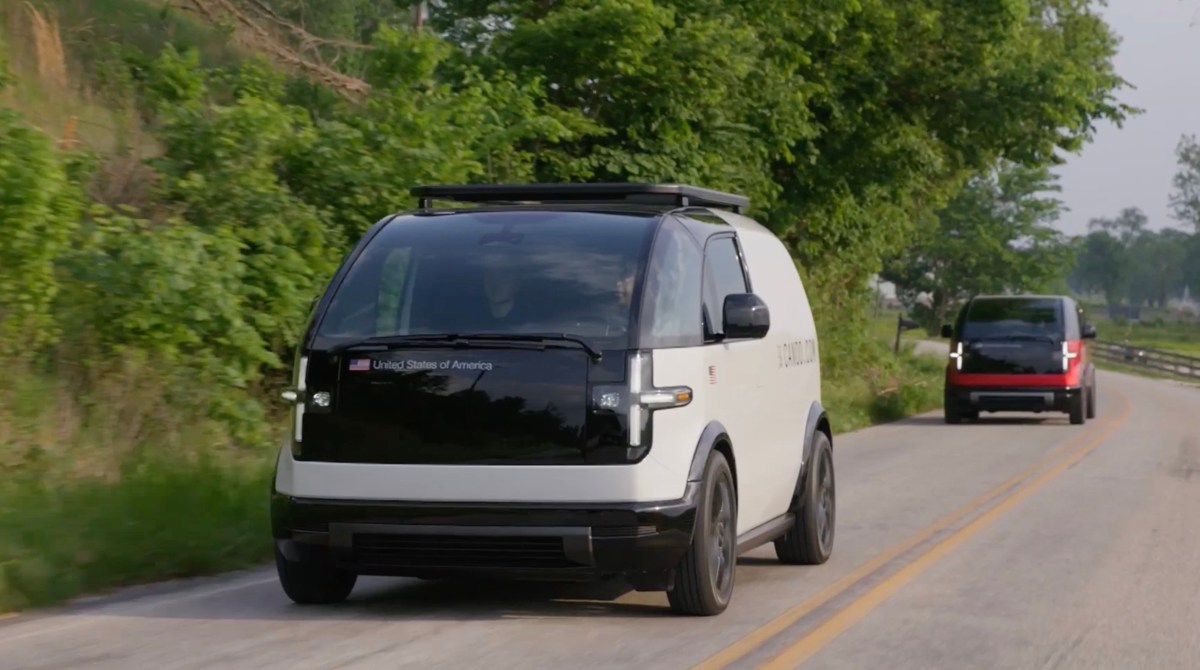The Rise and Fall of Canoo: A Cautionary Tale in the EV Industry
A Promising Start, a Troubled Path
Table of Contents
- A Promising Start, a Troubled Path
- Funding Woes and Missed Opportunities
- A Financial Picture Painted in Red
- A Timeline of Decline
- The SPAC Model: A Double-Edged Sword
- From SPAC Hype to Bankruptcy’s Brink
- From SPAC Hype to Financial Distress
- Navigating the Complexities of Funding and Market Competition
- The SPAC Model: A Legacy of Uncertainty
- A Dream Deferred: Canoo’s Initial Promise
- Navigating Turbulence: Shifting Strategies and Leadership Changes
- A Cautionary Tale: Canoo’s Struggles in the Dynamic EV Landscape
- The Uncertain Future: A Crossroads for Canoo
- Financial Woes and Conflicts of Interest: Adding to the Strain
- Navigating Financial Turbulence
- A Lifeline Amidst Growing Distress
- Signs Pointing Towards Uncertainty
- The Road Ahead: A Path Filled with Obstacles
Canoo, an electric vehicle (EV) startup that burst onto the scene seven years ago with ambitious goals, has filed for Chapter 7 bankruptcy, marking a dramatic end to its journey. The company announced its decision to cease operations immediately and liquidate its assets in the Delaware Bankruptcy Court. This news sends shockwaves through the EV industry, which has witnessed a surge in both innovation and competition in recent years.
Funding Woes and Missed Opportunities
Canoo’s downfall can be traced back to several factors, including its struggle to secure vital funding. The company revealed in its bankruptcy filing that it engaged in discussions with foreign investors but ultimately failed to reach a deal. Adding to their woes, Canoo expressed disappointment over unsuccessful attempts to obtain funding from the U.S. Department of Energy’s Loan Program Office, which has been actively supporting EV startups during the Biden administration. This highlights the intense competition for resources within the EV sector and the crucial role that government support plays in fostering innovation.
A Financial Picture Painted in Red
Canoo’s financial struggles were evident even before its bankruptcy filing. The company reported significant losses over several consecutive quarters, raising concerns among investors and analysts. Despite attempts to streamline operations and reduce costs, Canoo was unable to achieve profitability. This underscores the immense challenges faced by EV startups in navigating a complex and capital-intensive market.
A Timeline of Decline
- 2019: Canoo emerges as an ambitious EV startup with a unique vision for its vehicles.
- 2020-2021: Canoo secures funding through a SPAC merger, generating initial excitement and investor interest.
- 2022: Canoo begins facing financial difficulties, reporting significant losses and struggling to meet production targets.
- 2023: Canoo’s efforts to secure additional funding fail, leading to the company’s decision to file for bankruptcy.
The SPAC Model: A Double-Edged Sword
Canoo’s initial success was partly attributed to its decision to go public through a special purpose acquisition company (SPAC) merger. While SPACs offer a faster and less complex path to the public markets compared to traditional IPOs, they also come with inherent risks. Canoo’s experience highlights the potential pitfalls of relying on SPAC funding, particularly in a volatile market environment.
From SPAC Hype to Bankruptcy’s Brink
The rapid rise and subsequent fall of Canoo serves as a cautionary tale for other EV startups. The company’s story demonstrates the importance of sustainable business models, robust financial planning, and a clear path to profitability in an increasingly competitive industry.
The Rise and Fall of Canoo: A Cautionary Tale in the EV Landscape
From SPAC Hype to Financial Distress
The electric vehicle (EV) industry is a dynamic landscape, marked by both exhilarating innovation and heartbreaking failures. Canoo, once a promising startup with ambitious goals, serves as a stark reminder of the challenges inherent in this sector. Despite initial excitement surrounding its unique modular platform and partnerships with prominent organizations like NASA and the US Postal Service, Canoo ultimately succumbed to financial pressures, filing for bankruptcy and painting a grim picture of missed opportunities.
Canoo’s story began with a group of experienced executives who sought to disrupt the EV market with a fresh approach. Their vision centered around a highly adaptable modular platform capable of transforming into various vehicle types, powered by cutting-edge technology like steer-by-wire systems. This innovative concept attracted significant attention, even fueling rumors of potential investment or acquisition talks with tech giant Apple in 2021.
The path to success for EV startups is often fraught with obstacles, particularly when it comes to securing funding and navigating intense market competition. Canoo’s journey was no exception. While the company initially benefited from a successful SPAC merger in 2020, providing a seemingly fast track to public markets, this model ultimately proved to be a double-edged sword. The reliance on SPACs, while offering a quicker route to capital compared to traditional IPOs, has also been associated with increased risk and scrutiny.
As the EV market matured, Canoo faced mounting pressure to deliver tangible results. The company’s financial situation deteriorated rapidly throughout 2024, culminating in a series of drastic measures. Canoo was forced to furlough its remaining workforce and idle its Oklahoma factory, clear indicators of its precarious financial standing. This decision, while necessary to conserve dwindling resources, further eroded investor confidence and highlighted the company’s struggle to compete in a rapidly evolving market.
The SPAC Model: A Legacy of Uncertainty
Canoo’s bankruptcy adds another chapter to the complex narrative surrounding EV startups and their reliance on SPACs. While SPACs initially offered a seemingly attractive alternative to traditional IPOs, providing a faster path to public markets, they have also become increasingly associated with risk and scrutiny. Electric Last Mile Solutions, which filed for bankruptcy in June 2022, served as an early warning sign of the potential pitfalls of this model.
Since then, other prominent EV startups like Fisker, Lordstown Motors, and others have faced significant challenges, raising serious questions about the long-term sustainability of the SPAC model in the EV sector.
Canoo’s Rollercoaster Ride: From Hype to Hard Reality
A Dream Deferred: Canoo’s Initial Promise
Canoo burst onto the electric vehicle (EV) scene with a bang, raising around $600 million through a SPAC merger with Hennessy Capital Acquisition Corp. The company painted a picture of a future where sleek, innovative EVs would revolutionize personal transportation. They secured partnerships with major players like NASA, the US Postal Service, and even Walmart (for a non-binding agreement of up to 10,000 EVs), fueling excitement about their potential.
However, Canoo’s journey quickly became a rollercoaster ride. Production remained limited despite the ambitious promises, and the company faced a series of leadership changes. The appointment of Tony Aquila as chairman and CEO brought a new wave of optimism, but even his entrepreneurial experience couldn’t fully overcome the challenges. The EV market was becoming increasingly competitive, with established automakers pouring resources into their own electric vehicle programs.
A Cautionary Tale: Canoo’s Struggles in the Dynamic EV Landscape
Canoo’s story serves as a stark reminder of the complexities and risks inherent in the EV industry. While innovation and ambition are crucial for success, they must be accompanied by robust execution, efficient production, and a clear path to profitability. The rapid evolution of the market demands constant adaptation and refinement. Companies like Tesla have demonstrated the power of continuous innovation and customer feedback, while others struggle to keep pace. Canoo’s experience highlights the need for startups to be agile, responsive to changing market conditions, and willing to pivot strategies when necessary.
The Uncertain Future: A Crossroads for Canoo
Canoo’s future remains uncertain. The company has shifted its focus from selling directly to consumers to targeting commercial fleets, a move that hasn’t yielded the desired results. Their manufacturing plans have been plagued by indecision, oscillating between building their own vehicles and outsourcing production. This lack of clarity has contributed to a sense of uncertainty surrounding Canoo’s long-term vision.
Financial Woes and Conflicts of Interest: Adding to the Strain
Canoo’s financial struggles have become increasingly apparent as they struggle to generate revenue. Adding to these concerns is the perception of conflicts of interest surrounding CEO Tony Aquila. His private firm, Aquila Capital, appears to benefit from his position at Canoo. In 2023 alone, Canoo spent twice its meager annual revenue on Aquila’s firm for the use of a corporate jet. This exorbitant expenditure raised eyebrows and fueled speculation about the company’s financial management.
Canoo’s story is a reminder that even in a rapidly evolving industry like EVs, success requires more than just ambition. It demands sound strategy, efficient execution, and ethical leadership.
Canoo’s Troubled Journey: A Cautionary Tale in the EV Market
The electric vehicle (EV) market is a fiercely competitive landscape, and startups often face significant challenges in securing a sustainable business model. Canoo, once a promising contender, has recently found itself grappling with financial instability, raising concerns about its future viability. Regulatory filings revealed that Canoo also rented office space from Aquila Capital, a situation that blurred the lines between personal gain and corporate responsibility, casting a shadow over Canoo’s operations. This entanglement further complicated Canoo’s already precarious financial position.
A Lifeline Amidst Growing Distress
In an attempt to stem the tide of its financial woes, Aquila Capital stepped in to provide Canoo with crucial financial support. The struggling company received several million dollars in loans from Aquila Capital, secured by assets at Canoo’s Oklahoma City facility. These loans served as a temporary lifeline for Canoo, allowing it to continue operating amidst mounting challenges. However, despite this intervention, signs of impending bankruptcy became increasingly apparent.
Signs Pointing Towards Uncertainty
Reddit users observed that Canoo’s billboard outside its office in Justin, Texas, had been removed, a clear indication of financial distress. Employees on furlough received official termination notices, signaling a further contraction of the company’s workforce. Additionally, individuals who had placed deposits when Canoo was still targeting individual consumers began receiving refunds, suggesting a shift in the company’s business strategy.
The Road Ahead: A Path Filled with Obstacles
Canoo’s story serves as a cautionary tale about the complexities and risks inherent in the EV market. The company’s inability to secure a sustainable business model, coupled with financial mismanagement and conflicts of interest, ultimately led to its current predicament. While Canoo may explore various options to navigate this challenging period, including seeking additional funding or restructuring its operations, the road ahead will undoubtedly be fraught with obstacles.
For aspiring entrepreneurs in the EV sector, Canoo’s experience highlights the importance of meticulous planning, sound financial management, and a clear understanding of market dynamics. To learn more about navigating the complexities of the EV industry, visit our comprehensive guide on EV Industry Trends.


